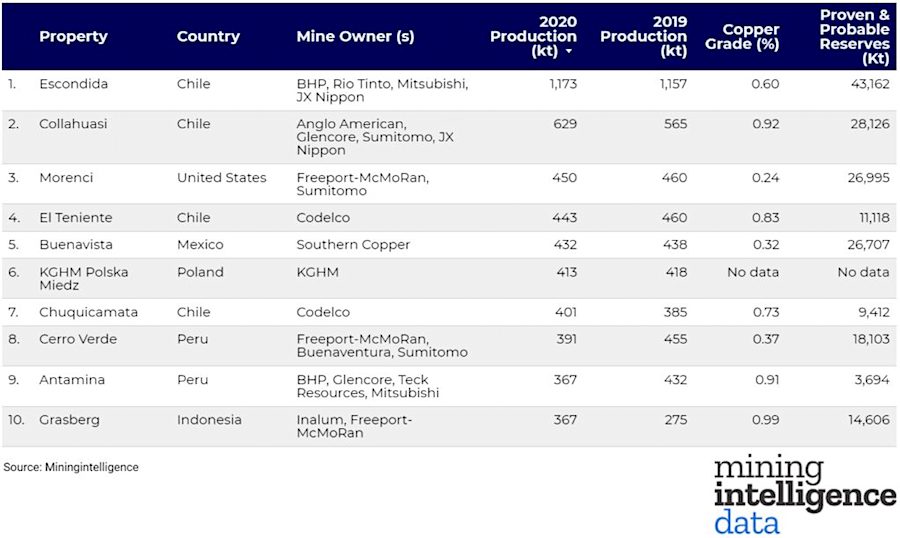
Monday, May 31, 2021
Friday, May 28, 2021
World's first liquefied-hydrogen carrier unveiled

https://www3.nhk.or.jp/nhkworld/en/news/20210525_27/
A Japanese shipbuilder is leading the race to transport what some say is the eco fuel of the future. Kawasaki Heavy Industries has built the world's first vessel dedicated to carrying liquefied hydrogen.
The company says the Suiso Frontier can hold enough of the material to fill about 15,000 fuel-cell vehicles.
It's planning a test run by the end of the current fiscal year to bring liquefied hydrogen from Australia to Japan.
Hydrogen emits no carbon dioxide. The Japanese government wants to increase the country's use of it 10-fold to around 20 million tons a year by 2050.
Thursday, May 27, 2021
Gold price tops $1,900 for first time since early January

The US Capitol rotunda. Credit: Wikipedia.
Gold prices topped $1,900 for the first
time since the early days of 2021, as investors continue piling money
into gold-backed funds while US Federal Reserve officials commit to a
dovish stance.![]()
Spot gold rose 0.2% to $1,901.88 per ounce by noon ET, after hitting its highest since January 8 at $1,911.95 an ounce. US gold futures gained 0.4%, trading at $1,904.00 an ounce in New York.
[Click here for an interactive chart of gold prices]
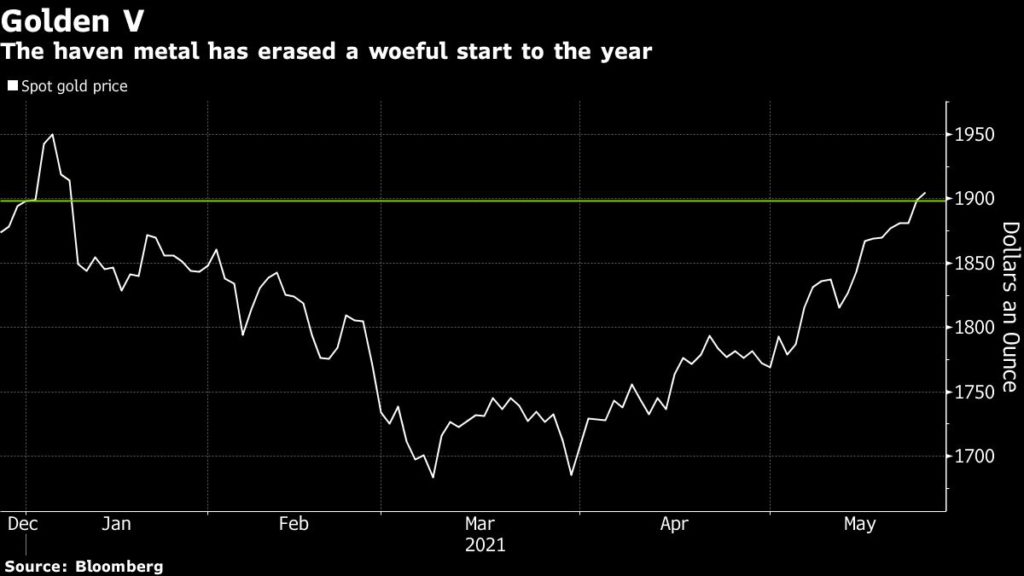
In a Yahoo! Finance interview on Tuesday, Fed Vice Chair Richard Clarida said the US central bank could curb an outbreak of inflation should it occur without throwing the recovery off track. He also added that signs of inflation would “prove to be largely transitory.”
That echoed a number of recent dovish comments from the US central bank, which sent the yield on 10-year notes to the lowest in two weeks, helping bullion erase this year’s losses. Investor holdings of bullion-backed ETFs have risen in 12 of the past 13 sessions.
“Apart from the recent weakness in US treasury yields, factors including dovish Fed commentary to calm speculation about tightening policy has attracted flows into gold,” Xiao Fu, head of commodities markets strategy at Bank of China International, told Reuters.
“Gold seems to be underpinned around $1,900 as the dollar has been quite weak recently and could provide some safe haven demand for gold,” Fu added.
Gold has been dogged by an improving US economic outlook earlier in the year following fresh fiscal aid and success of vaccine rollout, which investors feared could see monetary stimulus tapered earlier than expected. However, weak US job numbers have helped assuage any concerns of tightening.
Meanwhile, there have been signs of inflationary pressures building in commodity markets and snarled supply chains as the global economy returns to normal, burnishing gold’s appeal as a hedge.
“This could now spark technical follow-up buying that would drive the gold price up further,” Daniel Briesemann, an analyst at Commerzbank AG, said in a note to Bloomberg.
“Coupled with the higher consumer demand that is expected and reviving investment demand, we believe this should lend buoyancy to the gold price.”
(With files from Bloomberg an Reuters)
Biggest copper mining project in decades begins production
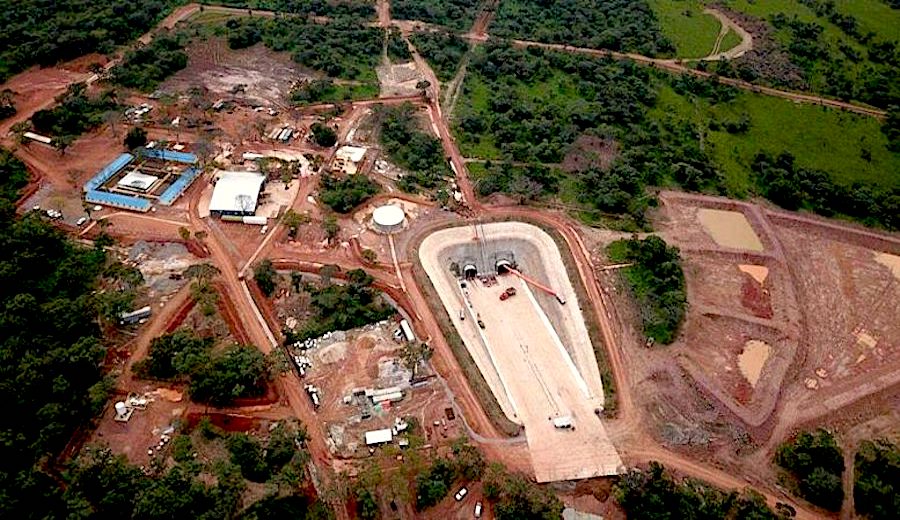
Kamoa-Kakula copper project, 25 km west of Kolwezi in the Democratic Republic of the Congo. (Image courtesy of Ivanhoe Mines.)
Canada’s Ivanhoe Mines (TSX: IVN) has begun producing copper concentrate at its Kamoa-Kakula project in the Democratic Republic of Congo (DRC) months ahead of schedule as the metal continues to trade close to all-time highs.
Kakula, the first mine planned at the concession, is initially forecast to generate 3.8 million tonnes of ore a year at an average feed grade “well in excess of 6% copper” over the first five years of operation, the company said.
Ivanhoe and partner Zijin Mining said first ore was introduced into the concentrator plant on May 20 to perform initial hot commissioning tests on the ball mills and other processing equipment.
As of May 25, 5% to 6% of copper ore was being conveyed directly from Kakula’s underground mining operations to the run-of-mine stockpile and the concentrator.
Operations are set to ramp up this year to reach between 80,000 and 95,000 tonnes of copper in concentrate, eventually reaching an annual peak of more than 800,000 tonnes
Ivanhoe’s co-chairperson Robert Friedland described first production from Kamoa-Kakula as a “historic moment” for Ivanhoe and the DRC. The country’s President, Felix Tshisekedi, said it was a clear sign that the country was open for business and investment.
“Discovering and delivering a copper province of this scale, grade and outstanding ESG credentials, ahead of schedule and on budget, is a unicorn in the copper mining business,” Friedland said in a separate statement.
The mining veteran noted that while the exploration journey started well over two decades ago, the Kakula deposit was discovered a little over five years ago. “This is remarkable progress by the mining industry’s glacial standards from first drill hole to a new major mining operation,” he said.
Kicking off production at Kamoa is indeed a momentous event for the copper market. Most of the current top producing mines are decades old and, except rare exceptions such as SolGold’s Cascabel in Ecuador and Anglo American’s Quellaveco project in Peru, there haven’t been major new discoveries in years.
While copper projects are in the pipeline, producers are wary of repeating oversupply mistakes of past cycles by speeding up plans at a time when mines are getting a lot trickier and pricier to build — one reason why copper prices are near decade highs at above $4 per pound.
The copper industry needs to spend upwards of $100 billion to close what could be an annual supply deficit of 4.7 million metric tonnes by 2030, according to estimates from CRU Group. The potential shortfall could reach 10 million tonnes if no mines get built, commodities trader Trafigura has said.
Friedland, who made his fortune from the Voisey’s Bay nickel project in Canada in the 1990s, has been working on Kamoa-Kakula for ten years.
World’s no.2, and the greenest
Operations at Kamoa-Kakula are set to ramp up this year to reach between 80,000 and 95,000 tonnes of copper in concentrate. After several phases of expansion, the mine’s peak annual copper production will be more than 800,000 tonnes.
The executive believes the project will become the world’s second-largest copper mine and also the one with the highest grades among major operations. The concentrator is slated to produce concentrate grading around 57% copper.
See how Kamoa-Kakula fares among the world’s top 10 biggest copper mines:
The Vancouver-based company has also vowed to produce the industry’s “greenest” copper, as it works to become the first net-zero operational carbon emitter among the world’s top-tier copper producers. Friedland has not set a target date for achieving that goal.
Expansion in sight
Given the current copper price environment, Ivanhoe and Zijin are exploring expanding production capacity from the current 7.6 Mtpa capacity (to be implemented in two phases of 3.8 Mtpa) to 11.4 Mtpa. This may be achieved by adding output from other targets in the concession — Kansoko, Kamoa North (including the Bonanza Zone) and Kakula West.
Kamoa-Kakula is a strategic partnership between Ivanhoe Mines (39.6%), Zijin Mining Group (39.6%), Crystal River Global Limited (0.8%) and the DRC government (20%).
Shares in Ivanhoe shot up on the news, trading 3.4% higher at C$9.31 a piece in Toronto early morning. So far this year, the stock has climbed almost 25%.
BMO Metals Andrew Mikitchook said Wednesday’s news was an important milestone for Ivanhoe shareholders. “We expect further revaluation of the shares as the mine ramps up over the next months and the Phase 2 expansion (remains ahead of schedule) is delivered by Q3 2022,” he said.
Looking ahead, Mikitchook said investors would watch for three Kakula-Kamoa milestones: ongoing monthly operational updates, 2021 costs guidance, and updates on copper concentrate offtake arrangements.
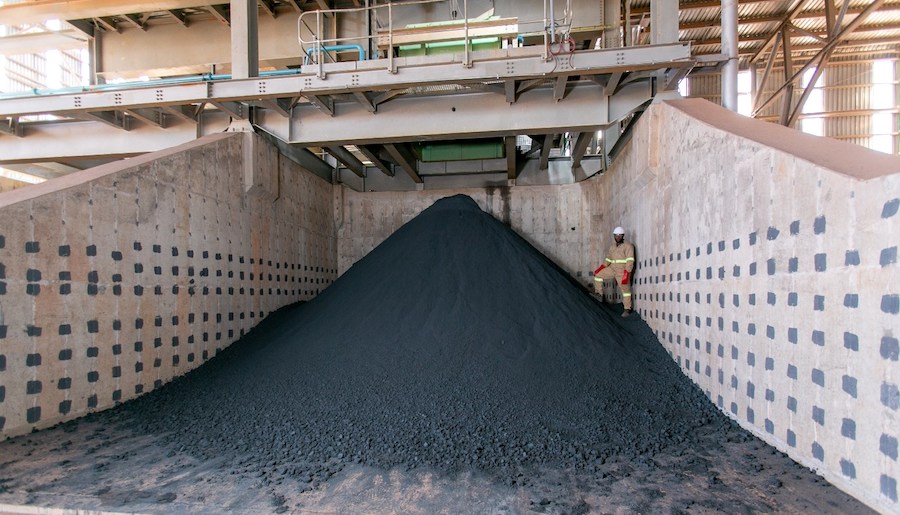
Wednesday, May 26, 2021
Tuesday, May 25, 2021
Gold price holds near 4-month peak despite bitcoin rebound

Gold prices steadied near the highest in more than four months on Monday amid signs that investors are turning more bullish on the precious metal. Declines in the US dollar and bond yields also helped bullion’s appeal.
Spot gold stayed relatively flat, up 0.1% to $1,883.59 an ounce by 1:20 p.m. ET, while US gold futures rose 0.4% to $1,884.60 an ounce.
[Click here for an interactive chart of gold prices]
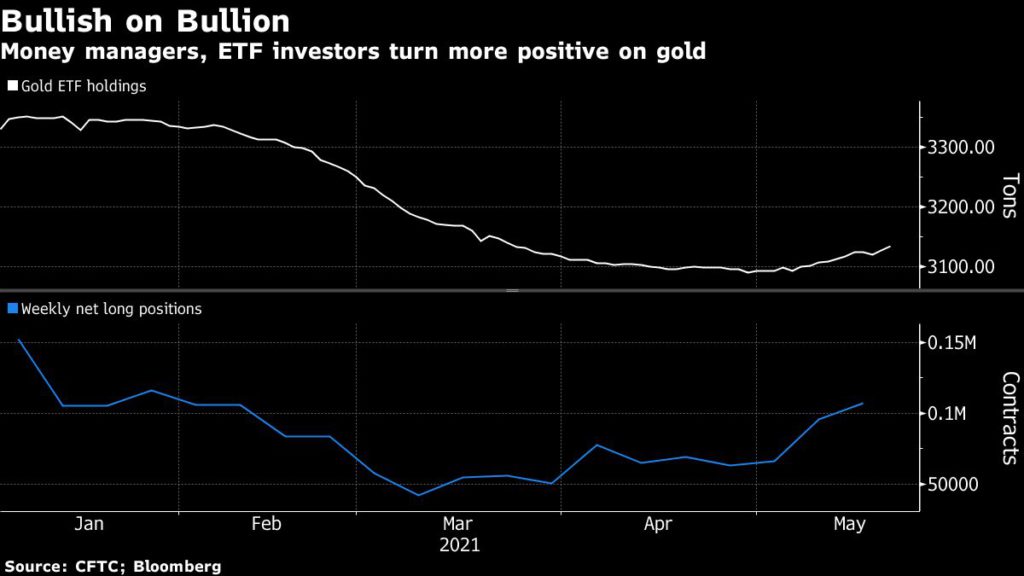
Gold is coming off three straight weekly gains, closer to wiping out its losses for the year after prices slumped during the January-March period. The precious metal has advanced on wobbles in the greenback and weakening treasury yields, and demand for bullion as a store of value is rising as inflation worries threaten to undercut economic growth.
Over the past week, hedge funds and other large speculators have raised their net-long position in gold futures and options to the highest since January, government data showed on Friday. Holdings in exchange-traded funds backed by bullion also climbed in May following three months of outflows.
Investors were also weighing the extreme volatility in Bitcoin – widely viewed as an alternative to gold – which may have lent an added pillar of support. However, the cryptocurrency rebounded from its roller-coaster weekend on Monday, with prices on track for the biggest gain in more than three months.
“Gold prices are trending higher as weakness in cryptocurrencies and rising demand for inflation-hedge assets buoyed the appeal of the precious metal,” Margaret Yang, a strategist at DailyFX, told Bloomberg.
“Recent ETF data showed that investors are stockpiling the yellow metal for the first time since January, underscoring rising appetite.”
Related read: The bitcoin crash of 2021 compared to past sell-offs
“The recent move lower in real rates, accompanied by further US dollar weakness, have been the key drivers of gold’s rebound,” Morgan Stanley analysts led by Susan Bates said in a note on Monday.
“Still, we continue to see a risk of a sharper sell-off similar to that seen in 2013 once tapering begins in 2022, but in our base case we assume price remains supported in the $1,600s per ounce until the first Fed rate hike,” they added.
(With files from Bloomberg)
Monday, May 24, 2021
Column: U.S. Gasoline Consumption Nears Pre-Pandemic Level
![items.[0].image.alt](https://ewscripps.brightspotcdn.com/dims4/default/ce92a63/2147483647/strip/true/crop/640x360+0+60/resize/1280x720!/quality/90/?url=https%3A%2F%2Fsharing.thedenverchannel.com%2Fsharescnn%2Fphoto%2F2017%2F07%2F03%2FS042377589-300_1499097474425_62175055_ver1.0_640_480.jpg)
U.S. traffic volumes have almost returned to pre-pandemic levels, helping normalise gasoline consumption as more businesses re-open, domestic leisure travel resumes and workers return to offices.
The volume of traffic on all roads was down by less than 4% in March compared with the same month two years ago, according to the Federal Highway Administration (“Traffic volume trends” FHWA, March 2021).
Traffic levels had been down 41% in April 2020 at the height of the first wave of the pandemic and were still down 11% as recently as December 2020 during the second wave.
Car use likely increased further in April and May as social-distancing restrictions were relaxed and more service businesses and offices re-opened.
More driving means more fuel consumption.
The volume of gasoline supplied to the domestic market, a proxy for consumption, was down by just 4% at 8.9 million barrels per day in the four weeks to May 14 compared with the pre-pandemic five-year average of 9.3 million b/d.
The remaining driving and fuel deficits are likely to be erased over the third quarter as more employees return to central offices and domestic tourism recovers.
The rapid normalisation of gasoline consumption has encouraged a strong resumption of motor fuel production, which is nearing pre-pandemic levels.
Refinery gasoline production is down by just 3% compared with the five years from 2015 to 2019, according to the Energy Information Administration (“Weekly petroleum status report”, EIA, May 19).
Like the driving and consumption deficits, refiners’ gasoline production is likely to reach pre-pandemic levels during the summer
The enormous surplus that accumulated during the pandemic’s first wave has been absorbed. Inventories held at refineries, tank farms and in pipelines are back in line with the pre-COVID five-year average.
Jet fuel consumption is still severely affected by quarantine restrictions. But in the gasoline market the impact of the pandemic appears largely over, provided there is no resurgence of infections.
Friday, May 21, 2021
Thursday, May 20, 2021
Tanker owners ask to switch ports for Israel oil deliveries, sources say
*Source: EAPC Ltd.
At least two tanker owners delivering crude oil to Israel have asked to divert from Ashkelon to the port of Haifa because of fighting, shipping sources said on Friday.
The most serious fighting between Israel and Gaza militants since 2014 began on Monday after the enclave's ruling Hamas group fired rockets at Jerusalem and Tel Aviv in retaliation for Israeli police clashes with Palestinians near al-Aqsa mosque in Jerusalem. read more
On Tuesday, an industrial area near Ashkelon was hit by a rocket from Gaza damaging a storage tank owned by Israeli state-owned Petroleum & Infrastructures Ltd which runs a network of fuel pipelines. read more
Israel has two refineries. One is run by Paz Oil near Ashkelon with a capacity of 100,000 barrels per day (bpd) and the other by Bazan Group near Haifa with a capacity of nearly 200,000 bpd.
The sources said the tankers asking to switch ports were carrying oil from the Black Sea.
Our Standards: The Thomson Reuters Trust Principles.
Wednesday, May 19, 2021
Tuesday, May 18, 2021
Iron ore price rebounds as China steel output hits all-time high
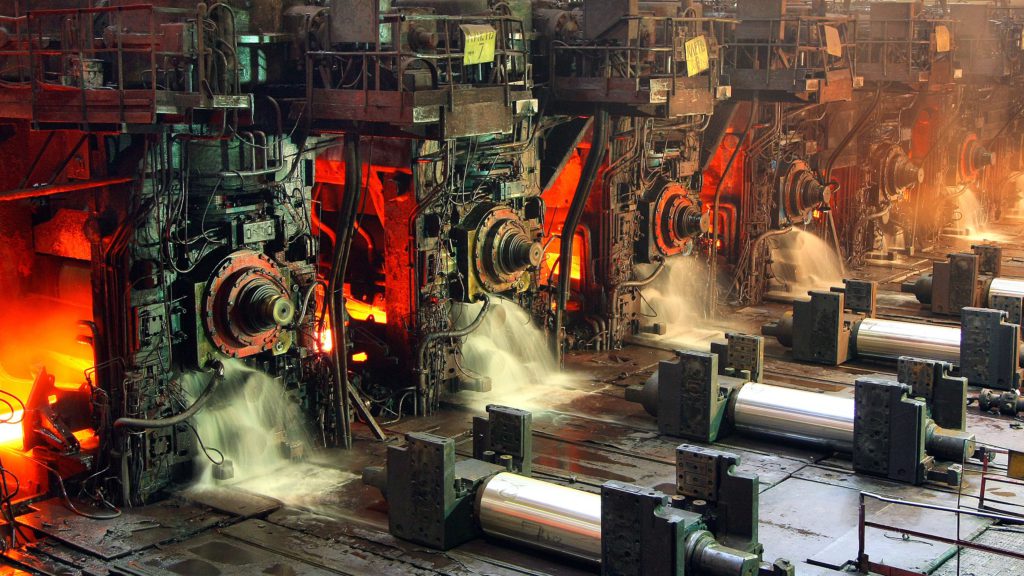
Iron ore prices climbed back on Monday as China’s steel output hit a record high despite the government’s pledge to curb annual production to reduce pollution and increase costs from raw materials.
The robust pace of production also lifted the year-to-date tally to 375 million tonnes, a 16% jump compared to same period last year. This comes as iron ore stockpiles at Chinese ports declined for the third week, indicating strength in demand.
Benchmark 62% Fe fines imported into Northern China (CFR Qingdao) were changing hands for $217.77 a tonne on Monday, up 4.3%, according to Fastmarkets MB.
Fastmarkets’ 62% Fe iron ore fines index experienced its most volatile week on record last week. After a new high-water mark of $237.57 per tonne on Wednesday, the index plummeted on Friday with a record daily loss of -$28.78.
“We don’t believe runaway iron ore prices are down to a macro reinflation trade on futures markets. While iron ore’s highly liquid paper contracts can certainly impact sentiment, the hallmarks of genuine physical tightness are evident in the details,” said Peter Hannah, Index Manager at the commodity price reporting agency.
“Firstly, expanded quality differentials signal consumers’ willingness to pay up to raise productivity. The premium the 65% Fe Fines Index commands over the 62% Fe hit a record level too in recent weeks and is a key bellwether of steel mills’ profit motive.
Higher prices for low-impurity brands bought and sold at Chinese ports compared with their seaborne traded levels (more than $50/t for Vale’s Brazilian Blend) have reflected a strong appetite for immediate consumption of the most desired chemistries, Hannah said.
“You would not expect to see this if speculation were the main driver of the rally,”
“As China’s steel production still continues to expand, its steel margins remain elevated and seaborne iron ore supply remains constrained, we think that the iron ore price can stay around the current level through 2Q, but is likely to remain highly volatile,” analysts at Morgan Stanley wrote in a note.
Related read: Analysts not convinced the iron ore price run has legs
Futures prices for construction rebar and hot rolled coils have jumped 32% and 38% so far this year
Iron ore rocketed higher early last week, prompting the authorities to crack down further on the steel sector. Steel mills from Tangshan to Shanghai were warned not to fabricate or spread price hike information after Premier Li Keqiang urged the nation to deal with surging prices.
“Besides increasing output at long-processing mills that are not subject to curbs, production at electric arc furnaces also gained,” Liu Xinwei, chief researcher with Sublime China Information told Reuters.
Futures prices for construction rebar and hot rolled coils have jumped 32% and 38% so far this year, respectively.
The bourse in Dalian has raised trading limits for iron ore, while the Shanghai Futures Exchange plans to raise trading limits of deformed steel bar and hot-rolled sheet futures from Tuesday on.
“The government may intervene but they were caught in between their policy of urbanization — which needs steel or ore and keeping consumption up — and their wish to control pollution and the iron ore price,” Philip Kirchlechner, director at Iron Ore Research Pty told Bloomberg.
“If the speculative component is big enough, any rumor about changes in government policy can push the price down again. This is what might be happening.”
(With files from Bloomberg and Reuters)
Exxon Retreats from Oil Trading in Pandemic as Rivals Made Fortunes

Photo: Loomis
The cuts left Exxon traders without the capital they needed to take full
advantage of the volatile oil market, these people said.
The coronavirus pandemic sent prices to historic lows — with US oil trading below zero at one point — before a strong rebound.
That created an immense profit opportunity for trading operations willing to take on the risk.
Exxon instead systematically avoided risk by pulling most of the capital needed for speculative trades, subjecting most trades to high-level management review, and limiting some traders to working only with longtime Exxon customers, according to interviews with 10 former employees and people familiar with Exxon’s trading operation.
Traders were restricted to mostly routine deals intended as a hedge for Exxon’s more traditional crude and fuel sales rather than gambles seeking to maximise profit, four of the people said.
The trading retreat came after Exxon had worked in the previous three years to bolster its trading unit with revamped facilities, high-level hires and new tools to help traders take on more risk.
The company’s cautious strategy in the pandemic sparked the exodus of some of those senior-level new recruits, along with Exxon veterans, as the company downsized the department amid broader spending cuts, according to the people familiar with its trading operation.
“They were careful with capital during a period of time when they maybe shouldn’t have,” one trader who left Exxon in the last year said of its management.
Exxon’s trading retreat came as the company overall posted a historic $22.4bn net loss in 2020.
Exxon does not separately report the performance of its trading unit, Reuters was not able to determine the trading department’s overall profit or loss, or the specific reduction it made in capital available for speculative trading.
Some of Exxon’s biggest rivals made enormous trading profits last year as their traders bought oil and stored it when prices plunged, then sold it at higher prices for future delivery.
Rival Royal Dutch Shell said in March that it doubled its 2020 trading profits to $2.6bn over the previous year, BP Plc’s trading arm earned about $4bn, a near record, Reuters reported previously, based on an internal BP presentation. Such profits helped both companies offset massive losses from a collapse in fuel demand and prices as the pandemic curtailed travel worldwide.
Exxon declined to comment on whether it scaled back speculative trading or reduced the department’s capital and staffing.
An Exxon spokesman said its trading team continues to have a “broad footprint.”
“We’re pleased with our progress over the past couple of years,” said spokesman Jeremy Eikenberry.
The cutback in Exxon’s trading operation comes amid broader setbacks. The firm’s stock, after hitting its lowest level in nearly two decades last year, was removed from the Dow Jones Industrial Average, an index of the top 30 US companies.
The firm’s cash flow declined sharply, and its debt rating was cut two notches in 12 months.
Exxon said in October that the firm would eliminate 14,000 jobs, about 15% of its global workforce, by the end of 2021.
Among the belt-tightening measures: asking US office workers to empty their own trash bins, two sources said.
Top oil trading firms make money by buying and selling oil to take advantage of price differences in different markets, a strategy known as arbitrage.
They also speculate on futures contracts, betting on whether the oil price will rise or fall by specific dates, the big players include trading units at major oil producers such as BP, as well as specialized merchants such as Trafigura AG.
The risks are high, but successful trading desks can deliver returns of 20% to 25%, much higher than other parts of the oil-and-gas business, estimated Andy Brogan, a partner at advisory firm EY and leader of its oil-and-gas practice, in an October EY publication.
Exxon, the largest US oil producer, has historically viewed trading skeptically and limited its activity.
After Darren Woods became CEO in 2017, however, he broke with tradition and sought to build up the company’s small trading unit.
The company began hiring consultants, recruiting veteran traders and revamping its trading floors in Spring, Texas, and Leatherhead, England
Among the hires were well-regarded traders and marketers from firms including commodity trader Glencore Plc and US refiners Andeavor and Phillips 66.
Exxon equipped the expanded staff with risk management tools to help trading executives assess potential losses, laying the foundation for a bolder strategy, two people familiar with the operation said.
CEO Woods initially pledged last March that the firm would “lean
into” the oil-market decline by continuing major investments across the
company.
He reversed course a month later, ordering broad spending cuts as oil fell below $30 a barrel.
Woods vowed to protect a $15bn-a-year shareholder dividend as Exxon’s stock price tumbled.
By contrast, Shell and BP reduced their dividends.
Exxon’s decision contributed to deep spending cuts and heavy borrowing across the US oil giant, which took on about $21bn in debt last year
The quick retreat of Exxon’s revamped trading desk underscores the firm’s longstanding aversion to risk, said Anish Kapadia, director of energy at Palissy Advisors.
“The trading business is a risk business,” he said. “That has never been one of Exxon’s fortes.”
Exxon cancelled an early 2020 trading strategy meeting at Exxon’s Irving, Texas, headquarters.
After that, “everything went on hold,” said one person close to the company.
The oil-market collapse in April triggered a working capital freeze in the trading group, a former Exxon trader told Reuters.
As cost-cutting continued throughout 2020, the trading operations in Texas and England began sending expatriate workers back to their home countries to save on allowances for housing, cars and tuition benefits, said two people familiar with the moves.
Exxon’s financial woes and restrictions on trading led to the exodus of many department staffers, including senior traders and managers, according to three former trading employees and others familiar with the operation
Exxon laid off some trading employees and offered others early retirements or severance packages, the people said, while more staffers left through attrition.
Reuters could not determine the total number of departures.
Among the prominent departures were Exxon veteran Steve Scott, who led Exxon’s British crude oil trading operation in Leatherhead, people familiar with the matter said.
They also included Ben Knowles, who was behind Exxon’s exports to Europe and Asia; and Nelson Lee, who while at oil producer BHP Billiton orchestrated some of the first exports of US crude in decades before joining Exxon in June 2018
Scott and Knowles could not be reached for comment. Lee declined to comment
Monday, May 17, 2021
Vale set to receive first-ever wind-powered ore carrier
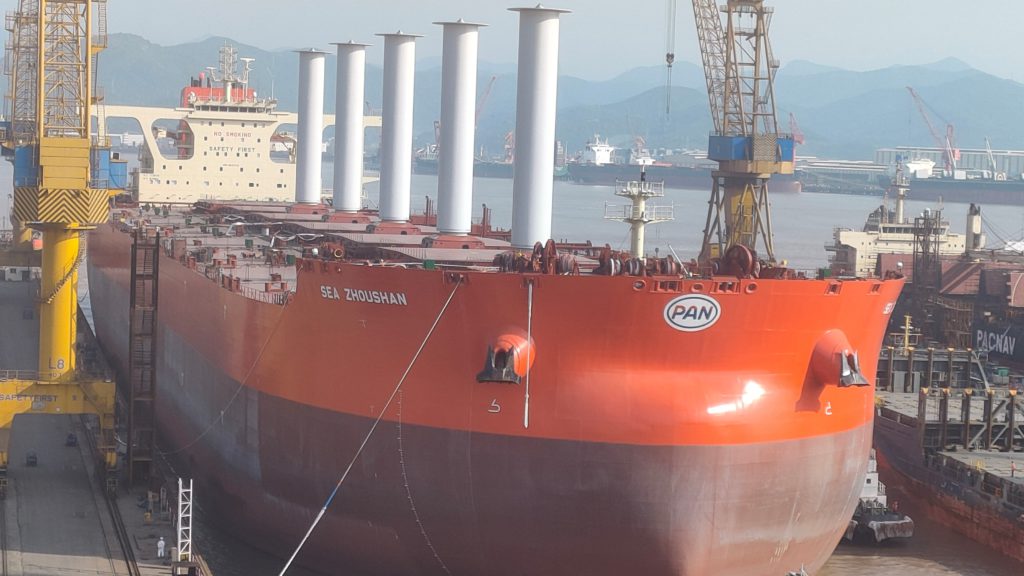
Vale has been working to reposition itself in recent years as a trailblazer for sustainability in the mining industry (Image: Vale)
Vale expects to receive in coming weeks its first-ever mineral transport ship propelled in part by sails, the company said on Thursday.
The ship, a VLOC, or very-large ore carrier, will also be the largest ever to be outfitted by the rotating sails, Vale said in a statement.
The sails in question are large metal cylinders four meters in diameter and 24 meters tall. While underway, the cylinders spin at different velocities, creating air pressure differences that help propel the ship forward.
Vale has been working to reposition itself in recent years as a trailblazer for sustainability in the mining industry
“Wind energy was how commercial navigation started. It was forgotten about in the last few centuries, and it’s coming back,” Rodrigo Bermelho, Vale’s head of marine engineering, told Reuters in a video interview.
Vale has been working to reposition itself in recent years as a trailblazer for sustainability in the mining industry, with executives increasingly focusing on the company’s potential role in supplying electrical vehicle manufacturers.
The ship in question, which has a load capacity of 325,000 tons and has five sails, will be 8% more energy efficient, equivalent to 3,400 tons of carbon dioxide per year, Bermelho said.
If the project proves successful, at least 40% of the company’s 114 Guiabamax and Valemax ships could also be retrofitted. Retrofitting all those ships with sails, Bermelho said, would reduce Vale’s shipping-related emissions by 1.5%.
While Brazil’s geographic distance from China – its main export market – is a relative disadvantage, the Brazil to Asia route is on average windier than the route from mining powerhouse Australia to mainland Asia, Bermelho said.
(By Marta Nogueira and Gram Slattery; Editing by Andrea Ricci)
Friday, May 14, 2021
Colonial Pipeline pays $5 million to ransomware gang, report

Credit: Getty
https://www.dailydot.com/debug/colonial-pipeline-5-million-ransomware/
Colonial Pipeline reportedly paid nearly $5 million to a cybercriminal
gang on Friday after the company’s systems were targeted with
ransomware.
Despite initial claims that the company did not intend to pay, Bloomberg reported on Thursday that Colonial Pipeline agreed to the extortion fee in an effort to restore its services.
The company, which operates a pipeline that transports close to half of the East Coast’s fuel, is said to have transferred the DarkSide ransomware gang millions of dollars in cryptocurrency just hours after being infected.
After receiving the payment, DarkSide provided Colonial Pipeline with a decryption tool designed to give the company access back to its own files. Yet the tool reportedly worked so slowly that the company ultimately ended up relying more on its own server backups.
Colonial Pipeline, which intentionally halted its services in an effort to contain the ransomware’s spread, has since stated that it believes it will return to full operating capacity by the end of Thursday.
The incident is largely unsurprising to some, including the author of a 2018 audit of Colonial Pipeline’s network who argued that “an eighth-grader could have hacked into that system.”
Concerns over the ransomware incident led to panic buying at gas stations across the East Coast, leading to fuel shortages as a result.
The company, which operates a pipeline that transports close to half of the East Coast’s fuel, is said to have transferred the DarkSide ransomware gang millions of dollars in cryptocurrency just hours after being infected.
After receiving the payment, DarkSide provided Colonial Pipeline with a decryption tool designed to give the company access back to its own files. Yet the tool reportedly worked so slowly that the company ultimately ended up relying more on its own server backups.
Colonial Pipeline, which intentionally halted its services in an effort to contain the ransomware’s spread, has since stated that it believes it will return to full operating capacity by the end of Thursday.
The incident is largely unsurprising to some, including the author of a 2018 audit of Colonial Pipeline’s network who argued that “an eighth-grader could have hacked into that system.”
Concerns over the ransomware incident led to panic buying at gas stations across the East Coast, leading to fuel shortages as a result.
DarkSide, a suspected Eastern European group which has only been active for around six months, is believed to have generated more than $30 million so far through its extortion efforts.
Although the FBI currently recommends that targets of such hacks not pay, reports suggest that funds received by ransomware groups continue to increase. In 2020 alone, victims are believed to have paid over $350 million in cryptocurrency in total after being targeted by ransomware.
In the wake of the pipeline incident, President Joe Biden on Wednesday announced a new executive order aimed at strengthening the country’s digital defenses.
Thursday, May 13, 2021
Pipeline Inspector Calls In To The Alex Jones Show: “It’s 100% A Manufactured Collapse”

From Houston to Linden, New Jersey. Courtesy Colonial Pipeline Company
An oil and energy expert calling in to the Alex Jones Show Wednesday claimed the US fuel crisis and gas shortages were part of a “manufactured collapse.”
“You’re 100 percent right,” says the caller, who claims he’s surveyed the Colonial Pipeline in the past.
“I’ve spent 15 years working in the oil and gas industry and also the energy industry, I just finished working 10 months in California and I’ve seen what they’re doing there, and it’s 100 percent a manufactured collapse.”
“If they wanted this thing going they would send guys out and open the valves up and get gas flowing tomorrow. They don’t need the electrical instrumentation to do that. So this is 100 percent a manufactured crisis. They’re trying to collapse the country.”
Wednesday, May 12, 2021
Tuesday, May 11, 2021
Gas stations along Southeast coast suffer fuel shortage amid pipeline shutdown

https://nypost.com/2021/05/11/southeast-coast-suffers-gas-shortage-amid-pipeline-shutdown/
Gas stations along the Southeast coast are beginning to feel the pinch from the shutdown of the biggest oil pipeline in the US due to a crippling cyberattack believed to be orchestrated by a Russia-based criminal group.
The closure of the 5,500-mile Colonial Pipeline, which carries more than 100 million gallons of fuel from Texas to New Jersey each day, has stretched into its fifth day. The Alpharetta, Georgia-based company suspended all operations after it was hit Friday by a ransomware attack that could prove to be among the most costly in US history.
Colonial said Monday it hopes to get most of its operations back online by the weekend, but that’s not soon enough to avoid shortages and price hikes as supply has already started to dwindle.
About 7.6 percent of gas stations in Virginia were out of fuel by early Tuesday, according to GasBuddy analyst Patrick DeHaan’s estimates. He added that nearly 5 percent of gas stations in North Carolina, 3.3 percent in Georgia as well as 2.4 percent in Florida are also reporting that they’ve sold out of fuel.
The shortages spurred North Carolina Gov. Roy Cooper to declare a state of emergency on Monday to help ensure the state maintains a sufficient fuel supply.
Panic buying appears to have exacerbated the limited supply. DeHaan said that across Georgia, Florida, South Carolina, North Carolina and Virginia, demand for gasoline rose more than 40 percent.
Supermarket chain Ingles, which operates gas stations across North Carolina, South Carolina, Georgia and Tennessee, is already seeing shortages and running completely out of gas at some of its locations, CFO Ron Freeman told the Citizen Times.
At an Exxon Mobil station in Asheville, North Carolina, a clerk answered the phone with “Hello, I’m currently out of gas,” according to Bloomberg. The outlet added that another station in Manning, South Carolina, had bagged their pumps and marked them “Out of service.”
Latest statewide numbers for gas stations without gasoline as of 6am CT according to GasBuddy data.
— Patrick De Haan (@GasBuddyGuy) May 11, 2021
GA 3.3%
AL 0.4%
TN 0.02%
SC 1.5%
NC 4.8%
FL 2.4%
VA 7.6%
Note: these numbers may be low as our data stream is only hours old and more updates flow in. https://t.co/A5TguUjDzT
Atlanta-based RaceTrac confirmed to WSBTV-2 that some of its Georgia gas stations are already reporting temporary outages. And WBTW-TV reported lines at stations across South Carolina, from Marion and Mullins to Myrtle Beach, are growing longer as drivers scramble to stock up on gas.
Concerns about gas shortages and images of panic buying rolled in on social media Monday night.
In a meeting on Monday, Colonial’s chief executive Joseph Blount warned state officials that supply shortages could occur throughout the week as the company and the federal government work to get operations back up and running, Bloomberg reported. The outlet added that the White House said it is “monitoring supply shortages in parts of the Southeast.”
While the company said Monday that it’s manually operating a portion of the pipeline running from North Carolina to Maryland, most of the line is still down. Colonial is working with the federal government to investigate and respond to the hacking. Commerce Secretary Gina Raimondo said Sunday that an “all-hands-on-deck” effort is underway to restore operations.
This gas station in Robbinsville is all out of gas. Clerk said manager told her it could be five days before they have gas again. Says phone has been ringing off the hook of people calling around to find gas @WLOS_13 pic.twitter.com/SCcwmb1Pc0
— Caitlyn Penter (@CaitlynWLOS) May 10, 2021
“We are working closely with the company, state and local officials to make sure that they get back up to normal operations as quickly as possible and there aren’t disruptions in supply,” Raimondo said.
On Monday, the FBI confirmed the cyberattack was carried out by a professional gang of hackers known as “DarkSide.”
DarkSide is known to extort cash from corporations and give a cut to charity, the Associated Press reported Sunday, citing sources familiar with the federal investigation.
In a statement reportedly posted on DarkSide’s website, the group claimed, “Our goal is to make money, and not creating problems for society. From today we introduce moderation and check each company that our partners want to encrypt to avoid social consequences in the future.”
No need to wonder why there's a #gasshortage on the east coast. Ole buddy had eight containers lined up at the Murphy across from Tanger 17 in Myrtle Beach. pic.twitter.com/RYBFLlQRyn
— TJ Lundeen (@lundeentj) May 10, 2021
The statement, provided to CNBC by the Boston-based security company Cybereason on Monday, added: “We are apolitical, we do not participate in geopolitics, do not need to tie us with a defined government and look for our motives.”
While President Biden stopped short Monday of linking the Kremlin and DarkSide, he said that “there is evidence that the actors’ ransomware is in Russia.”
During a White House briefing, Anne Neuberger, deputy national security adviser for cyber and emerging technologies, also described DarkSide as “a criminal actor” but said that “our intelligence community is looking for any ties to any nation-state actors.
Monday, May 10, 2021
Copper price hits record high as Chile gives bulls another reason to cheer

SX-EW processing at Chuquicamata mine in Chile. Image from Codelco.
The world’s top copper producer Chile is giving bulls another reason to cheer while prices soared to an all-time high on Friday as optimism about a global rebound from the pandemic spurs a surge across commodities markets.
Copper for delivery in July ended the day up 3.2%, with futures trading at $4.7490 per pound ($10,470 a tonne) on the Comex market in New York.
Chile’s lower house on Thursday approved a measure that would introduce progressive taxes on copper sales, potentially creating a total burden of more than 80% — or almost double that of other major copper-producing nations.
The measure, which would go into effect in 2024, still needs to be approved by the senate and could be blocked by the government in court. But if it succeeds, it could stall investments in a country where mature low-grade deposits need plenty of expenditure just to maintain output levels of about 5.7 million tonnes a year.
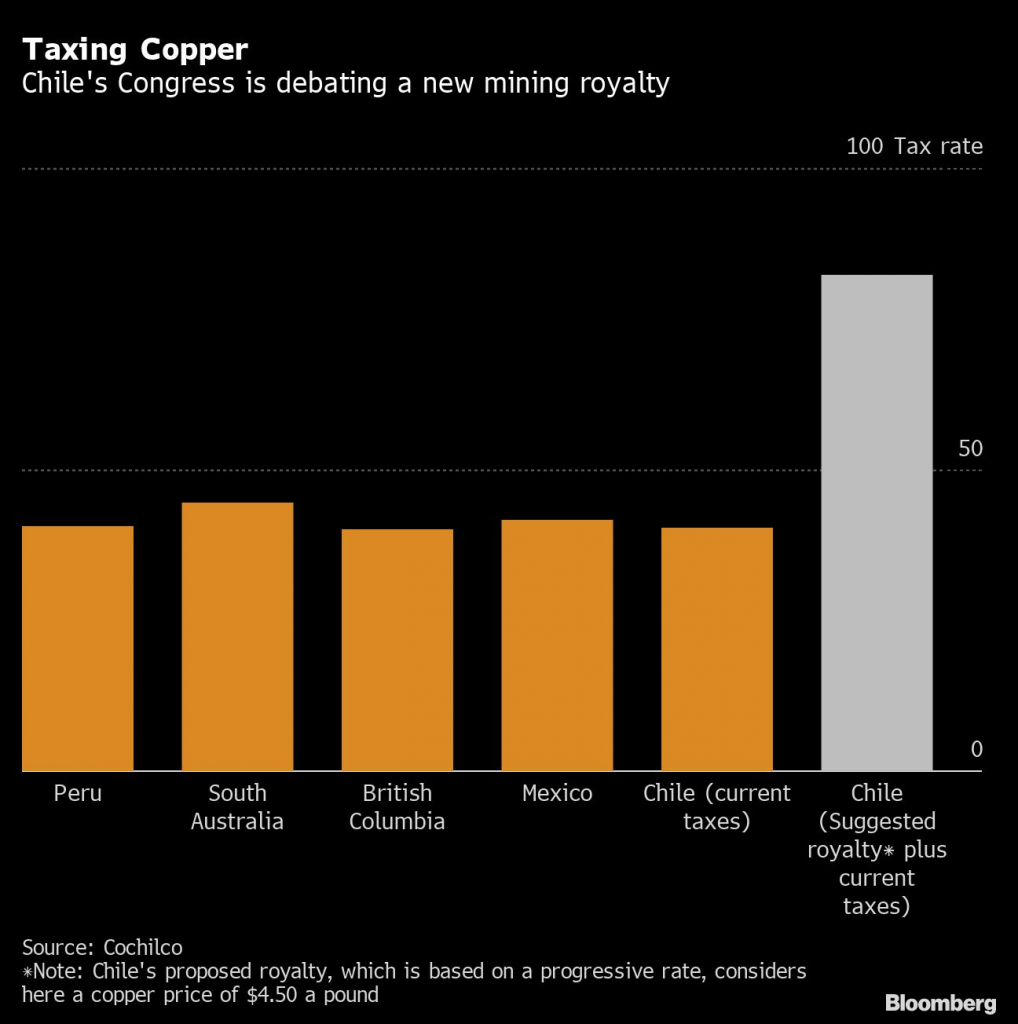
Related read: As China row deepens, 1 million tonnes of Australian copper concentrate needs new buyers
“This would at the very least delay any new capacity, extending the lengthy time-line to bring on a new mine,” said Grant Sporre, an analyst at Bloomberg Intelligence.
“Chile’s output could start to fade to 5 million tonnes.”
Chile’s copper export revenue jumped 69% in April. The world’s top copper producer said it had exported $4.541 billion worth of copper in April alone.
“The copper market as it currently stands is not prepared for this demand environment”
Goldman Sachs Group
Prices are up more than 30% this year and have more than doubled from lows in March of last year.
Click here for an interactive chart of copper prices

“Given high payments to the state, some assets would be un-investable and thus it limits the pool of mines that can make adequate returns, limiting supply,” said BTG Pactual analyst Cesar Perez-Novoa.
“No mining company is going to take risks without being rewarded.”
“It’s hard to foresee copper prices turning around amid the current bullish atmosphere,” Ji Xianfei, an analyst with Guotai Junan Futures told Bloomberg.
“Macro easing, ample liquidity and a weaker dollar continue to drive the rally, while the broader commodities surge is being fueled by bets on inflation.”
Trading house Trafigura Group, Goldman Sachs, and Bank of America expect copper to extend gains.
Steel prices across Asia and North America are also booming, iron ore is at a record above $200 per tonne as miners struggle to keep up with the frenzied pace of consumption, and tin topped $30 000 for the first time in a decade.
“The copper market as it currently stands is not prepared for this demand environment,” said Goldman Sachs Group Inc.
There are a few major mines in development and none on the scale required to meet forecasts for future demand.
“We don’t have many shovel-ready projects,” said Ivan Glasenberg, billionaire CEO of Glencore Plc.
“You will need the so-called $15,000 copper price to encourage a lot of this more difficult investment.”
Risks
There’s signs emerging in China, the top consumer, that high copper prices are starting to bite and authorities have pledged to stabilize raw material prices.
China’s imports of copper ore and concentrate fell in April from the previous month, according to customs data released Friday.
Some manufacturers and end-users have been slowing production or pushing back delivery times after costs surged, Shanghai Metals Market said last week.
(With files from Reuters and Bloomberg)
U.S. government working to aid top fuel pipeline operator after cyberattack
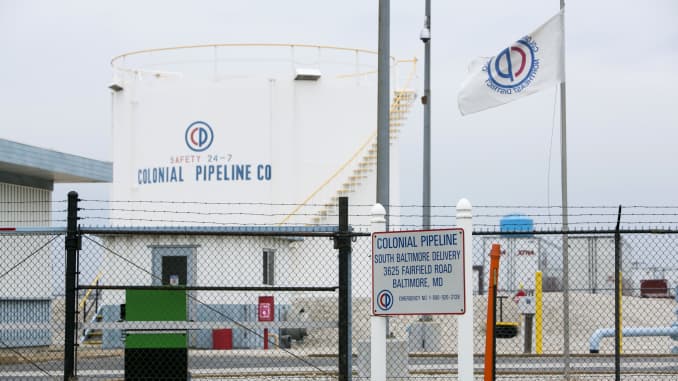
The White House was working closely with top U.S. fuel pipeline operator Colonial Pipeline on Sunday to help it recover from a ransomware attack that forced the company to shut a critical fuel network supplying populous eastern states.
The attack is one of the most disruptive digital ransom schemes reported and has prompted calls from American lawmakers to strengthen protections for critical U.S. energy infrastructure from hacking attacks.
Commerce Secretary Gina Raimondo said the pipeline fix was a top priority for the Biden administration and Washington was working to avoid more severe fuel supply disruptions by helping Colonial restart as quickly as possible its more than 5,500-mile (8,850 km) pipeline network from Texas to New Jersey.
“It’s an all hands on deck effort right now,” Raimondo said on CBS’ “Face the Nation” program. “We are working closely with the company, state and local officials, to make sure that they get back up to normal operations as quickly as possible and there aren’t disruptions in supply.”
Colonial said on Sunday its main fuel lines remain offline but some smaller lines between terminals and delivery points are now operational. Neither Raimondo nor the company gave an estimate for a full restart date and Colonial declined further comment on Sunday.
U.S. gasoline futures jumped more than 3% to $2.217 a gallon, the highest since May 2018, as trading opened for the week and market participants reacted to the closure.
Colonial transports roughly 2.5 million barrels per day of gasoline and other fuels from refiners on the Gulf Coast to consumers in the mid-Atlantic and southeastern United States.
Its extensive pipeline network serves major U.S. airports, including Atlanta's Hartsfield Jackson Airport, the world's busiest by passenger traffic.
A Charlotte Douglas International Airport spokesperson said the airport had supply on-hand and was "monitoring the situation closely," adding that the complex is supplied by another major pipeline as well as Colonial.
Retail fuel experts including the American Automobile Association said an outage lasting several days could have significant impacts on regional fuel supplies, particularly in the southeastern United States.
During previous Colonial outages, retail prices in southeastern states have risen substantially.
Offices of governors in several of the U.S. states most vulnerable to fuel shortages - including Tennessee, Georgia and Maryland - were not immediately available for comment.
CYBERCRIMINALS SUSPECTED
While the U.S. government investigation is in the early stages, a former U.S. official and three industry sources said the hackers are suspected to be a professional cybercriminal group called DarkSide.
DarkSide is one of many ransomware gangs extorting victims while avoiding targets in post-Soviet states. The groups gain access to private networks, encrypt files using software, and often also steal data.
They demand payment to decrypt the files and increasingly ask for additional money not to publish stolen content.
In the Colonial attack, the hackers took more than 100 gigabytes of data, according to a person familiar with the incident.
As the FBI and other government agencies worked with private companies to respond, the cloud computing system the hackers used to collect the stolen data was taken offline Saturday, the person said.
Colonial's data did not appear to have been transferred from that system anywhere else, potentially limiting the hackers' leverage to extort or further embarrass the company.
Cybersecurity firm FireEye (FEYE.O) is among those dealing with the attack, industry sources said. FireEye declined to comment. Colonial said it was working with a "leading, third-party cybersecurity firm," but did not name the firm.
Messages left with the DarkSide hackers were not immediately returned. The group's dark website, where hackers regularly post data about victims, made no reference to Colonial Pipeline.
Colonial declined to comment on whether DarkSide hackers were involved in the attack, when the breach occurred or what ransom they demanded.
BIDEN BRIEFED ON HACK
President Joe Biden was briefed on the cyberattack on Saturday morning, the White House said, adding that the government was working to try to help the company restore operations and prevent supply disruptions.
U.S. Senator Bill Cassidy, a Republican from Louisiana who sits on the Energy Committee, said lawmakers are prepared to work more with privately held critical infrastructure companies to guard against cyberattacks.
"The implication for this, for our national security, cannot be overstated. And I promise you, this is something that Republicans and Democrats can work together on," he said on NBC's "Meet the Press."
Another fuel pipeline serving the same regions carries a third of what Colonial does. Any prolonged outage would require tankers to transport fuels from the U.S. Gulf Coast to East Coast ports.
The Federal Motor Carrier Safety Administration is issuing a temporary hours of service exemption to truckers transporting refined products to 17 southern and east coast states including Alabama, Delaware, Florida, Georgia, New Jersey and New York.
Complicating the fallback plans, according to one industry source familiar with the federal response, was that the ranks of fuel-truck drivers for the main road transportation companies, which could pick up some of the pipeline volume, are down by 25% or more because of coronavirus infections.
Oil refining companies contacted by Reuters over the weekend said their operations had not yet been impacted. Some were working to find alternative transport for customers.
The privately held, Georgia-based company is owned by CDPQ Colonial Partners L.P., IFM (US) Colonial Pipeline 2 LLC, KKR-Keats Pipeline Investors L.P., Koch Capital Investments Company LLC and Shell Midstream Operating LLC.
Friday, May 7, 2021
The stampede to exit coal is a worrying harbinger for LNG: Russell
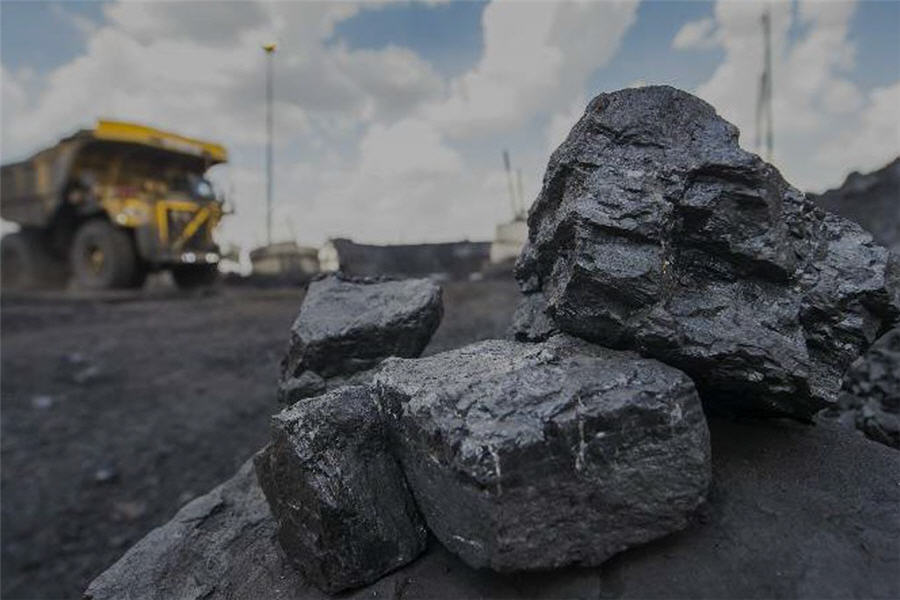
Image courtesy of Seriti Resources Holdings Ltd.
(The opinions expressed here are those of the author, Clyde Russell, a columnist for Reuters.)
A global diversified miner paying to exit its coal assets, and a multibillion-dollar dollar investment by Qatar to reclaim its status as the world’s largest producer of liquefied natural gas have more in common than might be visible at first glance.
South32, the Australian commodity producer spun out of BHP Group, is effectively handing over up to $250 million to Seriti Resources to take South African thermal coal operations off its hands.
While it’s not unusual for sellers of mining assets to cover rehabilitation costs, the sizeable amount involved shows just how much South32 wanted out of thermal coal – and in effect, just how little the assets are worth.
The sale of South32’s South African energy coal assets to Seriti is expected to close before the end of the company’s financial year
South32 is one of several major coal miners seeking to exit a business that has become increasingly problematic amid action by environmental activists, concern among shareholders and the withdrawal of financing and insurance for mines viewed as contributing to climate change.
In short, coal mines, particularly those producing thermal coal for use in power plants, are increasingly seen as a millstone around the neck of diversified miners. The latter would prefer to focus on producing commodities seen as essential to decarbonising the world’s energy systems.
There isn’t a straight line between the rush to exit coal and Qatar’s $28.7 billion plan to boost its LNG capacity 40% to 110 million tonnes by 2026, with a potential second-phase expansion to a total annual capacity of 127 million tonnes.
RELATED: Vale buys Mitsui’s stake in Moatize amid plan to exit coal
On the surface, such a massive investment in LNG would seem to be a vote of confidence in the future of the super-chilled fuel, touted by proponents as a cleaner-burning alternative to coal.
Still, the LNG business is condemned by opponents as producing enough pollution to still be part of the climate change problem. And Qatar’s push to produce more LNG could be view through a more cynical prism: the Gulf nation may be seeking to maximise the revenue from its extremely low-cost natural gas assets while it still can – before decarbonisation does to LNG what it’s busy doing to coal.
Qatar is believed to be able to produce LNG at a break-even cost of about $4 per million British thermal units (mmBtu), below the $5 to $8 per mmBtu for new projects in Mozambique, Russia and the United States, and the $7 to $11 for current top exporter Australia for new projects, according to figures from the Boston Consulting Group.
This in effect means Qatar can afford to take the view that even if there is an oversupply of LNG in the future, it will be the last producer standing, and it can monetise its natural gas reserves better than its competitors.
This raises the possibility that the billions of dollars currently being invested in LNG projects in places from Mozambique to Russia to North America may end up facing the same issues coal has right now – writing down the value of assets and struggling to sell them.
Coal exit stampede
Of course, for buyers of distressed coal assets such as Seriti, the opportunity remains to run the acquired mines for many years and sell the coal profitably to South Africa’s state-owned energy utility Eskom.
The sale of South32’s South African energy coal assets to Seriti is expected to close before the end of the company’s financial year, pending government approvals and an agreement with Eskom over coal supply.
The planned sale was first announced in November 2019 with Seriti, a company owned by Black South African investors, initially agreeing to pay 100 million rand ($6.7 million) upfront plus deferred payments based on future cash flows until March 2024, with a ceiling of 1.5 billion rand per year.
These terms have now changed, with the deferred payments scrapped, the purchase price reduced to a token 1 rand and South32 agreeing to pay for rehabilitation and other costs.
If the deal does go through, it will be the latest coal exit by a major mining company, following plans by Anglo American to spin off its South African coal assets and exit from its joint venture in Colombia, something BHP is keen to do as well.
Additionally BHP wishes to sell, or spin off, its energy coal assets in Australia, and earlier this year cut the value of its Mount Arthur thermal coal in New South Wales state by up to $1.25 billion, reflecting the market view that such assets have plunged in value.
It’s possible the present rush for the exit from coal will be matched by major oil and gas producers making a similar dash to get out of LNG in a few years time.
(Editing by Kenneth Maxwell)
Thursday, May 6, 2021
Venezuela oil exports stabilize at 700,000 bpd after stock drain - data

An oil tanker is docked while oil is pumped into it at the ships terminal of PDVSA's Jose Antonio Anzoategui industrial complex in the state of Anzoategui April 15, 2015. REUTERS/Carlos Garcia Rawlins
Venezuela's April oil exports were flat at about 700,000 barrels per day (bpd) for the third month in a row, with three-quarters of its shipments headed to Asia and the Middle East, according to tanker tracking data and documents from state-run Petroleos de Venezuela.
PDVSA's exports have stabilized in recent months following a sharp decline between late 2020 and early 2021 caused by U.S. orders to halt oil swaps that had allowed the exchange of Venezuelan crude for imported fuel.
A total of 25 cargoes set sail from Venezuelan waters last month, carrying 688,533 bpd of crude and fuel mainly to China, Malaysia and the United Arab Emirates. Exports to Europe fell to a single cargo of 110,000 barrels from two to three cargoes in previous months, the data and documents showed.
April volumes represented a 19% drop from the same month a year ago.
[For a graphic on Venezuela's monthly oil exports since 2020, click on: https://graphics.reuters.com/VENEZUELA-OIL/EXPORTS/xegpbqdzjvq/]
PDVSA and Venezuela's oil ministry did not immediately respond to requests for comment.
After exhausting most stocks of Merey and upgraded crude grades in April, PDVSA is preparing to restart two of its four upgraders, which in total are capable of converting over 600,000 bpd of extra heavy crude from the Orinoco belt into exportable grades.
The restarts could allow PDVSA to boost output from the Orinoco, the country's main producing region, while supplying more of its lightest grades to domestic refineries for motor fuel production. The lack of lighter oils has led to shortages of gasoline and diesel.
Among the exported cargoes this month, PDVSA sold a 991,000-barrel cargo of Corocoro crude, oil that had remained stored for over a year at the Nabarima floating facility, operated by the state firm and Italy's ENI (ENI.MI), the documents showed.
PDVSA also exported about 55,000 bpd of crude and fuel to its political ally Cuba, according to the data. Venezuela maintained imports within the range of previous months, of about 30,000 bpd.
